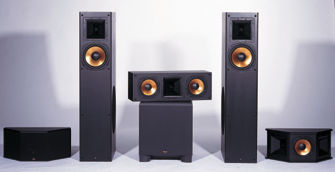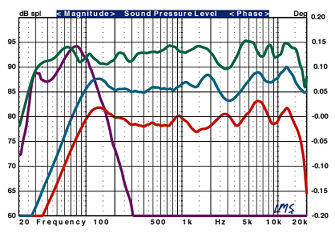Face Off: 3 Speaker Systems Around $3,500 Klipsch
I auditioned the Klipsch Reference Series speaker ensemble first. This system consists of a pair of RP-5 towers, an RC-3 center channel, and a pair of RS-3 dipole surrounds. I added a KSW-12 12-inch powered subwoofer for the bottom end.

Each RP-5 tower features a three-way system using a single 1-inch K-105-K titanium-dome compression driver with a Tractrix Horn, an 8-inch K-1084-S aluminum-cone midbass, and a 12-inch, side-firing subwoofer that's internally isolated from the midbass/horn section and is powered by a 165-watt amplifier.
Getting back to the horn section of the speaker, I should note that a true compression-style horn features an area between the diaphragm (compression driver) and the throat of the horn where the sound can "compress" before it's emitted through the horn mouth. There is no such space on the Tractrix Horn, so it more-closely resembles a waveguide than a true compression driver. The diaphragm is fitted with a phasing plug that limits the area in which the diaphragm operates, thus making it a compression driver.
Enough about horns. The rest of the Klipsch Reference ensemble has many noteworthy features. In terms of concept, I had a difficult time deciding which I liked best: the RC-3 center channel or RS-3 surrounds. The RC-3 features a single Tractrix Horn flanked by a pair of 61/2-inch aluminum-cone woofers. Weighing in at a hefty 29 pounds, this speaker obviously came to play—and play well. The RS-3 also has more than just driver appeal: It, too, utilizes a trapezoid shape that allows for a 180-degree coverage pattern. The surround features a pair of square Tractrix Horns and a single 61/2-inch woofer. I expected ambient things from this speaker in the evaluation.
I'd like to say I saved the last speaker in the system for the "best for last" category, but that isn't the case. The KSW-12 subwoofer falls short, by far, of the rest of the Klipsch speakers in the Build Quality category. As a rule of thumb, if I can pick up a subwoofer without any protest from my lower back, then it probably doesn't belong in the theater. Inside the ported enclosure, a single 12-inch, downward-firing woofer is powered by an internal 105-watt amplifier. The sub comes with most of the features you need to integrate it into any existing system. The low-pass crossover is continuously variable from 40 to 120 hertz, with a 24-dB-per-octave slope above 120 Hz, but can't be defeated if your receiver has a filtered low-pass output of its own. The sub does have a 180-degree phase selector, both high- and low-level speaker inputs and outputs, and an auto-on circuit.
For the listening evaluation, I first inserted the Eagles' When Hell Freezes Over DTS DVD. On the "Hotel California" selection, I noted excellent imaging and an incredibly large window in the sweet spot. The left and right sounded very smooth—that is to say there was a seamless transition between the Tractrix Horn and the midbass. The rear-channel information was incredibly ambient and sometimes lacked the concise reflection I listen for. The rear-channel program material is already recorded with phasing variables, and the processor compensates for the delay—the 180-degree radiating rears overextend the rear effects in music. This doesn't make it a poorly designed speaker—I simply prefer a direct-radiating speaker for music selections.
The only negative note I gave the Klipsch ensemble was in the vocals section. Vocals are emitted mainly from the center channel, and I struggled to hear the realism in the vocals of this selection. Overall, I found them to be nasally.
Moving right along, I popped in the Sheffield Laboratories "(Sittin' on) The Dock of the Bay" track to evaluate the system's two-channel performance. Knock two-channel if you wish, but many of Home Theater's readers (myself included) still listen to music in stereo. The Sheffield disc is a superb recording and a very revealing disc at that. For me, the selection again highlighted the excellent effort in the transition between the midrange and midbass and also between the mid and sub bass frequencies. This is an instrumental track, so there was no need to note vocal appearance.
The most important aspect of our evaluation is, of course, theater performance. Using my favorite new piece of demo material, I inserted the Phantom Menace laserdisc into the Pioneer Elite player. The scene's opening is quite a test of the endurance of the low-frequency extension (LFE). It was here that I was most surprised by the Klipsch Reference ensemble. After ragging on the subwoofer's poor build quality, I had to double-check to make sure I had connected the right sub (I had). This is certainly a capable system when it comes to delivering bass; however, at times I felt it was a bit too heavy on the bottom end. Of course, this is nothing an afternoon of tweaking wouldn't work out.
Highlights
• Excellent surrounds
• Ergonomic center channel
• Very efficient design
HT Labs Measures: Klipsch Reference Series

This graph shows the quasi-anechoic (employing close-miking of all woofers) frequency response of the RP-5 main L/R (green trace), KSW-12 subwoofer (purple trace), RC-3 center channel (blue trace), and RS-3 surround channel (red trace). All passive loudspeakers were measured at a distance of 1 meter with a 2.83-volt input and scaled for display purposes.
On-axis response of the RP-5 L/R measures +2.3/-3.4 decibels from 200 hertz to 10 kilohertz. The -3dB point is at 31 Hz, and the -6dB point is at 27 Hz. Impedance reaches a minimum of 3.9 ohms at 205 Hz and a phase angle of -61.4 degrees at 97 Hz. Sensitivity is 93 dB from 500 Hz to 2 kHz.
On-axis response of the RC-3 center measures +2.9/-2.7 dB from 200 Hz to 10 kHz. An average of axial and (+/-15 degree) horizontal responses measures +5.1/-1.1 dB from 200 Hz to 10 kHz. The -3dB point is at 84 Hz, and the -6dB point is at 72 Hz. Impedance reaches a minimum of 3.4 ohms at 210 Hz and a phase angle of -59.5 degrees at 111 Hz. Sensitivity is 94 dB from 500 Hz to 2 kHz.
Three-point averaged response of the RS-3 surround measures +5.0/-1.2 dB from 200 Hz to 20 kHz. The -3dB point is at 77 Hz, and the -6dB point is at 66 Hz. Impedance reaches a minimum of 3.7 ohms at 186 Hz and a phase angle of -60.1 degrees at 110 Hz. Sensitivity is 87 dB from 500 Hz to 2 kHz.
Close-miked response of the KSW-12 subwoofer, normalized to the average level from 40 Hz to 80 Hz, indicates that the lower -3dB point is at 48 Hz and the -6dB point is at 27 Hz. The upper -3dB point is at 118 Hz.—AJ

- Log in or register to post comments






























































